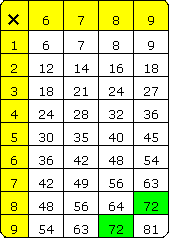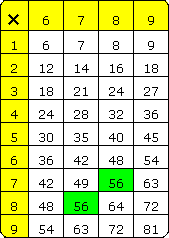Solved Examples and Worksheet for Exploring Commutative Property of Multiplication
Step: 1
Changing the order of factors does not change the product. This is commutative property of multiplication
Step: 2
Therefore, if 4 × 9 = 36, then 9 × 4 = 36.
[Commutative property of multiplication.]
Correct Answer is : 36
Step: 1
Changing the order of factors does not change the product. This is called commutative property of multiplication.
Step: 2
Value of the expression 10 × 11 = 110.
Step: 3
Value of the expression 11 × 10 = 110.
Step: 4
So, 10 × 11 = 11 × 10.
Correct Answer is : 11 × 10
A. 19
B. 12 × 7
C. 12 ÷ 7
D. 5
Step: 1
Changing the order of factors does not change the product. This is called commutative property of multiplication.
Step: 2
According to the choices, product of the expression is 7 × 12 = 12 × 7.
[commutative property of multiplication.]
Step: 3
So, 7 × 12 = 12 × 7.
Correct Answer is : 12 × 7
Step: 1
Changing the order of factors does not change the product. This is called commutative property of multiplication.
Step: 2
Product of the expression, 3 × 8 = 24.
Step: 3
Product of the expression, 8 × 3 = 24.
Step: 4
So, 3 × 8 = 8 × 3.
Correct Answer is : 8 × 3
Step: 1
Changing the order of factors does not change the product. This is called commutative property of multiplication.
Step: 2
Product of the expression, 4 × 7 = 28.
Step: 3
Product of the expression, 7 × 4 = 28.
Step: 4
So, 4 × 7 = 7 × 4.
Correct Answer is : 7 × 4
Step: 1
Changing the order of factors does not change the product. This is called commutative property of multiplication.
Step: 2
Value of the expression, 2 × 8 = 16.
Step: 3
Value of the expression, 8 × 2 = 16.
Step: 4
So, 2 × 8 = 8 × 2.
Correct Answer is : 8 × 2
- Multiplication Arrays-Gr 3-Solved Examples
- Multiplying 1-Digit Numbers by 1 Digit-Gr 3-Solved Examples
- Multiplying 2-Digit Numbers by 1-Digit Number-Gr 3-Solved Examples
- Number Sentences involving Multiplication-Gr 3-Solved Examples
- Dividing 2-Digit Numbers by 1-Digit Numbers without Remainders-Gr 3-Solved Examples
- Model Division using Equal Groups-Gr 3-Solved Examples
- Number Sentences involving Division-Gr 3-Solved Examples
- Finding Missing Number using Multiplication or Division-Gr 3-Solved Examples
- Multiplication and Division Facts-Gr 3-Solved Examples
- Exploring Associative Property of Multiplication-Gr 3-Solved Examples
- Distributive Property of Multiplication over Addition-Gr 3-Solved Examples
- Solving Two-step Word Problems-Gr 3-Solved Examples
- Application of Estimating Whole Numbers-Gr 3-Solved Examples
- Arithmetic Patterns Involving Addition and Multiplication-Gr 3-Solved Examples

